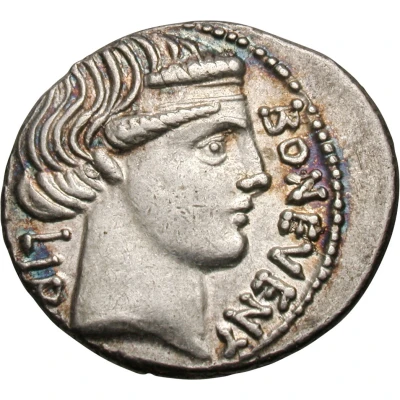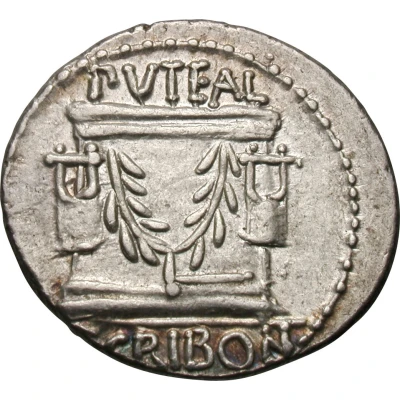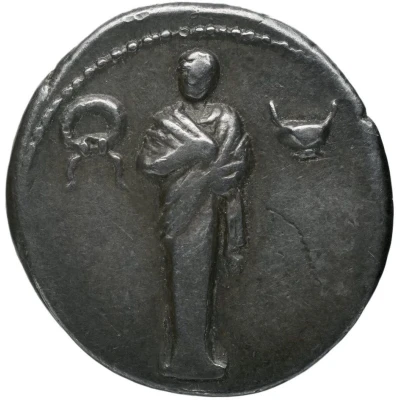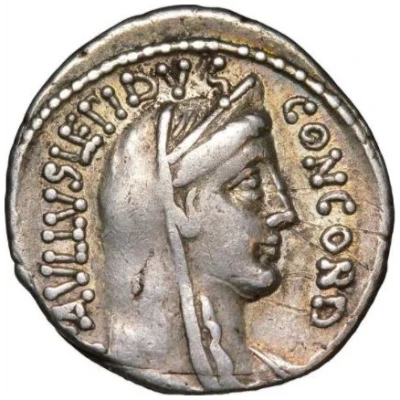
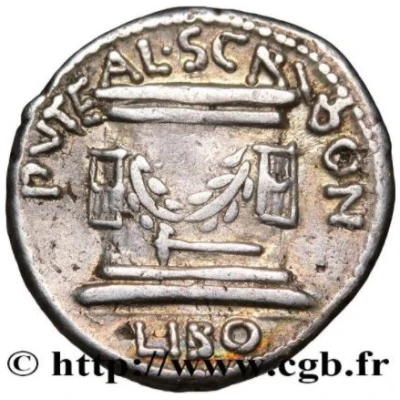

© CGB
Denarius Aemilia: Lucius Æmilius Lepidus Paullus 62 BC
62 BC year| Silver | 3.85 g | 19.83 mm |
| Issuer | Rome › Roman Republic (509 BC - 27 BC) |
|---|---|
| Period | Republic (509 BC - 27 BC) |
| Type | Standard circulation coin |
| Year | 62 BC |
| Value | Denarius (1) |
| Currency | Denarius of 16 Asses (141 – 27 BC) |
| Composition | Silver |
| Weight | 3.85 g |
| Diameter | 19.83 mm |
| Shape | Round (irregular) |
| Technique | Hammered |
| Orientation | Variable alignment ↺ |
| Demonetized | Yes |
| Updated | 2024-10-06 |
| Numista | N#234442 |
|---|---|
| Rarity index | 97% |
Reverse
Puteal Scribonianum, decorated with garland and two lyres. Border of dots.
Script: Latin
Lettering:
PVTE AL • SCRIBON
LIBO
Comment
"This is a joint issue by the coiners Paullus Aemilius Lepidus and Lucius Scribonius Libo . The type consists of the obverse of an older denarius and the reverse of another, the only difference being a slight alteration of the inscriptions in both cases. The aureus in the Vienna Cabinet of this type, like those of Paullus Lepidus (see p. 418), is false (Mommsen, Hist. mon. rom., t. ii., p. 499)." Coins of the Roman Republic in the British Museum, H.A Grueber, p. 420 (nota)"One of Rome's oldest and most illustrious patrician families, the gens Aemilia was of Sabine origin; it claimed descent from Mamercus, son of Pythagoras according to some, son of Numa according to others; Mamercus was given the name Aimilius because of his persuasive eloquence [...]. Another tradition gave the Aemilii as their ancestor Aimylos, son of Ascanius, from whom descended Numitor and Amulius, kings of Alba at the time of the foundation of Rome. This tribe was notably illustrated by the Paul-Emilus, Scaurus, Mamercus and Lepidus. Tacitus says: Aemilium genus fecundum bonorum civium. The coins it supplied to the Republic are numerous, and there are few families whose numismatics are as historically interesting. Coins are attributed to the following characters:
L. Aemilius Paullus (or Papus); Man. Aemilius Lepidus; M. Aemilius Scaurus; Paullus Aemilius Lepidus; L. Aemilius Buca; M. Aemilius Lepidus." Ernest babelon, Description historique et chronologique des monnaies de la république romaine, V. Aemilia, p.114.
"For this type, Mr. Crawford recorded an estimate of 26 right-hand corners and 29 reverse corners for two varieties (hammer and pliers). This type appears to be much rarer than general literature suggests" (CGB).
In addition, CGB also indicates a rarity level of R2. This is not very relevant given the number of specimens on CRRO (just 18 for 417/1a: http://numismatics.org/crro/id/rrc-417.1a
All authors apart from Babelon seem to forget to mention (rightly or wrongly, Babelon's work being quite old) a third variety that would replace the hammer or pincers with Vulcan's bonnet:
" Description historique et chronologique des monnaies de la république romaine; Babelon, n°11 Aemilia, p.123 (Parenthèses dans la description de la monnaie). No examples appear to be illustrated on the Internet.
Interesting fact
The Denarius coin , which features Lucius Aemilius Lepidus Paullus, was minted during a time of significant political upheaval in Rome. In 62 BC, the same year this coin was minted, Lucius Aemilius Lepidus Paullus was part of a group of conspirators who attempted to overthrow Julius Caesar, who was then the Roman dictator. The plot ultimately failed, and many of the conspirators, including Lepidus Paullus, were forced to flee Rome. Despite this, the coin bearing his image continued to be used as currency, providing a fascinating glimpse into the complex political landscape of ancient Rome.
